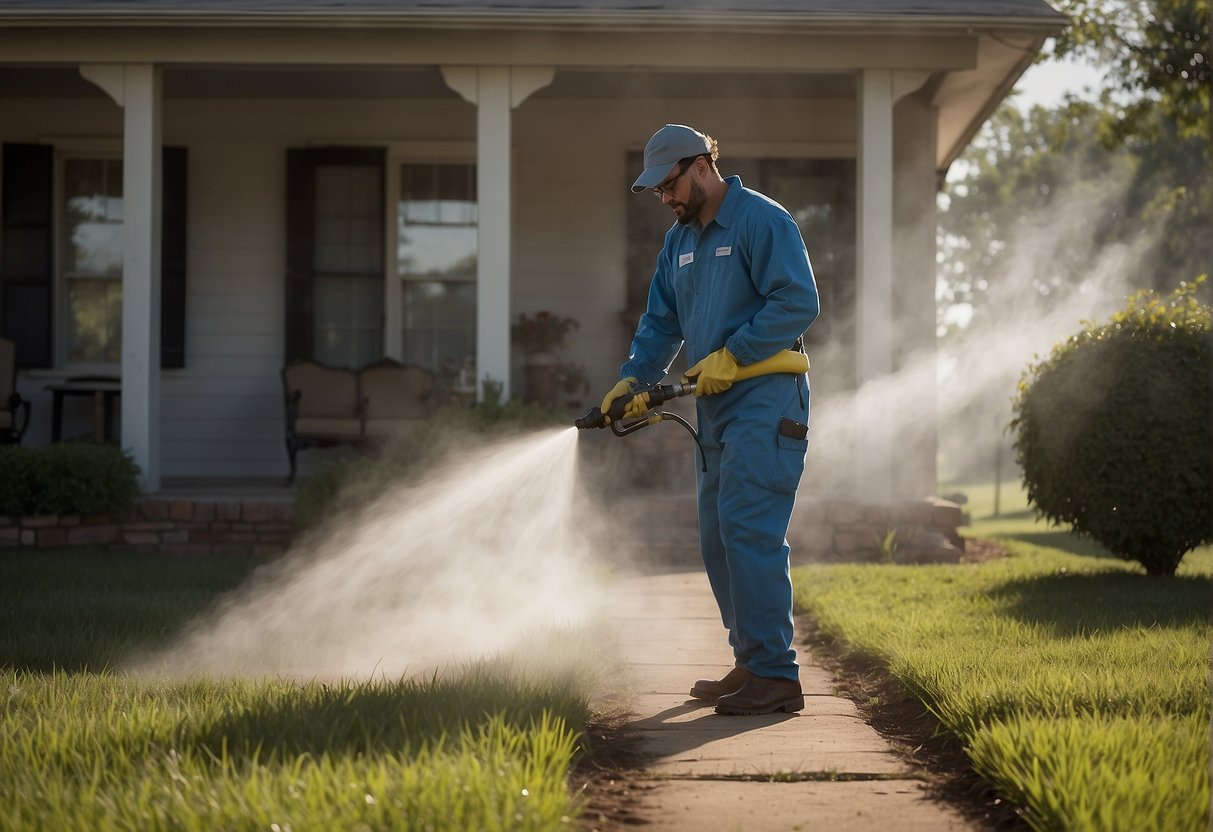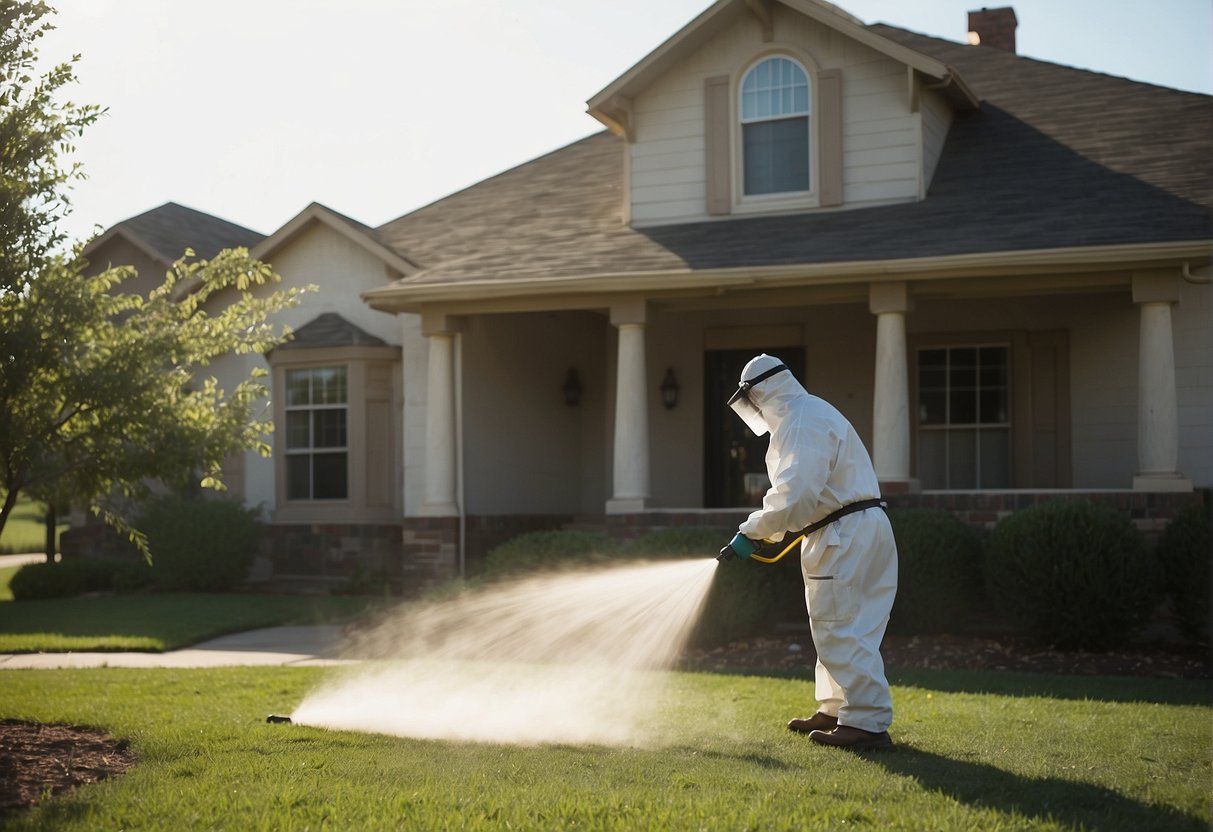
Pest Control and Prevention in Oklahoma: Simple Strategies for a Bug-Free Life
Pest control and prevention in Oklahoma are crucial aspects of maintaining a healthy and comfortable living environment. Homeowners in the state often face challenges in dealing with various pests, including termites, rodents, and insects that can cause serious damage to property and health. In this article, we will explore the importance of effective pest control methods and practices that can help homeowners in Oklahoma manage and prevent pest infestations.
Understanding pest control in Oklahoma involves being aware of the common pests found in the area and the specific issues they can cause. This knowledge is essential in implementing the right strategies and technologies to address varying infestation levels. Furthermore, it’s vital for homeowners to learn about the various professional pest control services available to them, as well as what preventative measures they can take to protect their property efficiently.
Termite inspection and control are particularly important, as these destructive pests can cause significant damage to Oklahoma homes if not treated promptly and properly. Maintenance and follow-up procedures also play a crucial role in keeping pests at bay, ensuring long-term efficacy of pest control methods and the overall safety of our living spaces.
Key Takeaways from Pest Control and Prevention in Oklahoma
- Effective pest control methods protect Oklahoma homeowners from property damage and health risks.
- Knowledge of common pests and available services helps implement targeted prevention strategies.
- Termite inspections, maintenance, and follow-up measures ensure long-term pest control success.
Understanding Pest Control in Oklahoma
Oklahoma is home to various types of pests that can cause significant damage to households and health concerns if left unattended. Effective pest control and prevention are essential for maintaining a clean and comfortable living environment. In this section, we’ll help you understand the common pests in the state of Oklahoma and the impact of climate on their activity.
Types of Common Pests in Oklahoma
The most common pests that can be found in Oklahoma include:
Ants: These tiny insects can be a nuisance in homes and gardens. Some ant species, such as carpenter ants, can even cause structural damage to your property by attacking the wooden elements of your house.
Termites: Termites can be extremely destructive to homes and buildings, causing millions of dollars in damage annually. They feed on cellulose-based materials, such as wood and paper, posing a significant threat to structures in Oklahoma.
Mosquitoes: Oklahoma’s warm, humid summers provide the perfect breeding environment for these pesky insects. Apart from their annoying bites, mosquitoes can spread dangerous diseases like West Nile virus and Zika.
Spiders: Home to a variety of spiders, some species in Oklahoma can be venomous, like the brown recluse and black widow. However, most spiders found in the state are harmless and help control other pest populations.
Flies: Common household flies can spread germs and contaminate food. Maintaining cleanliness and managing waste in and around homes is crucial to avoid fly infestations.
Rodents: Rats and mice are not just a nuisance, but also capable of spreading diseases and damaging your property. Their incessant gnawing on electrical cables, insulation, and wood can cause significant harm to homes and structures.
Roaches: Cockroaches, particularly German cockroaches, are abundant in Oklahoma. These pests can spread bacteria, contaminate food, trigger allergies, and even worsen asthma symptoms.
The Climate’s Impact on Pest Activity
Oklahoma’s climate plays a significant role in the level of pest activity throughout the year. The state experiences a wide range of weather conditions, from cold winters to hot and humid summers.
Winter: Although pest activity in Oklahoma tends to decrease during winter months, it is not uncommon to find some insects and rodents seeking warmth and shelter indoors.
Spring: As temperatures rise, pests begin to emerge. The combination of warm weather and increased rainfall makes spring an especially active time for termites, ants, and mosquitoes.
Summer: Summer’s high temperatures and humidity provide the perfect breeding conditions for mosquitoes, flies, and other insects. Also, some pests like spiders and roaches may move indoors during summer months to escape the heat.
Fall: As temperatures cool down, pests start seeking refuge in homes and buildings, preparing for the colder months ahead. This is the time when homeowners in Oklahoma might encounter increased rodent activity and see more spiders coming indoors.
Understanding the types of common pests in Oklahoma and how the state’s climate influences their activity is crucial for effective pest control. By being aware of these factors, you can take preventative measures to keep your home free from unwanted pests.
Professional Pest Control Services
Selecting a Pest Control Company
When it comes to pest control in Oklahoma City, a professional pest control service is the way to go. With so many options out there, how do you choose the right one for you? To start, ask for recommendations from friends and family or research online reviews. This will help you narrow down your choices.
Next, look for a pest control company that is licensed and insured in Oklahoma. You can confirm this by visiting the Oklahoma Department of Agriculture, Food, and Forestry website. Additionally, consider the following:
- Communication: A quality exterminator should listen to your concerns, answer your questions, and clearly explain how they will handle your pest problem.
- Experience: The longer a company has been in business, the more likely they are to have developed tried-and-true methods for effective pest control.
- Eco-Friendly Options: Many professionals offer environmentally conscious treatments, which can be an important consideration for those who prefer green solutions.
When to Call an Exterminator
It’s essential to recognize when to call an exterminator for pest control in Oklahoma City. Below are some common signs that it’s time to bring in a professional:
- You have persistent pest problems
- The infestation is severe, posing a health risk
- You want a long-term solution
- The pest problem is beyond your skillset (e.g., carpenter ants, termites, etc.)
- You value your peace of mind and prefer to let experts handle it
| Pests | Signs of Infestation |
|---|---|
| Ants | Ant trails, nests in soil or wood, and damaged wood structures |
| Cockroaches | Droppings, unpleasant odor, or egg cases |
| Rodents | Gnaw marks, droppings, and unusual noises in walls and ceilings |
| Termites | Mud tubes, discarded wings, and hollow-sounding wood |
| Carpenter Bees | Holes in wood structures, sawdust, and yellow stains on wood from larvae feces |
Remember, prevention is key to minimizing pest problems. So, properly sealing your home, maintaining your yard, and disposing of trash promptly can considerably reduce your chances of an infestation. However, when you find yourself dealing with a pest situation that requires professional help, choosing a reputable pest control company in Oklahoma City is vital to ensuring a safe and effective solution.
Preventative Measures for Homeowners

Identifying Entry Points
One of the most effective ways to prevent infestations is by identifying and sealing off possible entry points. Homeowners should inspect their homes regularly and look for any gaps, cracks, or other potential openings that could serve as an entryway for pests. Common entry points include doors, windows, vents, and utility lines. You can use weather stripping, sealants, or other appropriate materials to seal entry points and keep pests at bay.
DIY Vs. Professional Prevention
While some homeowners may opt for DIY pest control methods, there are distinct advantages to hiring professionals. Many pests, such as termites and bed bugs, may require specialized equipment and expertise to deal with effectively. Additionally, professional pest control services can offer tailored prevention and treatment plans to ensure a pest-free environment for your home.
For those considering the DIY route, it’s essential to be cautious when using chemicals and store them properly to prevent accidents. For more information, the Household Pest Control fact sheet provides tips on controlling infestations and identifying common home-invading arthropods.
In conclusion, both DIY and professional methods have their pros and cons. Always make sure to carefully weigh your options and consider what’s best for your home and family. Ultimately, taking preventative measures and maintaining a clean, well-maintained living space can go a long way in keeping your home pest-free.
Termite Inspection and Control

Termites can cause significant damage to your home or property in Oklahoma if left unchecked. In this section, we’ll discuss how to prevent termites, how to identify them, and the various treatment options available for termite control.
Termite Prevention Techniques
Preventing termites from entering your property is key to avoiding expensive damage. Here are a few techniques you can use to deter termites:
- Reduce moisture around your property by fixing leaks, keeping gutters clean, and ensuring proper drainage.
- Use termite-resistant materials when constructing new buildings or making repairs, such as pressure-treated wood or metal.
- Regularly maintain your property by removing dead wood, trimming back vegetation, and sealing any possible entry points.
Termite Inspection and Identification
Detection and proper identification of termites are crucial for effective termite control. Here is a brief overview of how to inspect and identify termites:
- Visual Inspection: Examine your property for any signs of termites, such as mud tubes, discarded wings, and wood damage.
- Acoustic Detection: Tap on wooden surfaces with a screwdriver to listen for hollow sounds, which may indicate termite tunnels.
- Professional Inspection: Hire a termite specialist to conduct a thorough inspection of your property, as they have the expertise and tools to accurately detect termites.
When identifying termites, it’s helpful to know what to look for. Termites are small, white, or brown insects, with long bodies and no waist. They have straight antennae, unlike ants, which have elbowed antennae. In Oklahoma, the most common termite species is the Eastern Subterranean Termite.
Once termites have been detected and identified, it’s essential to act quickly and determine the most effective treatment option. Here are a few common termite control methods:
- Liquid Termicides: These are applied to the soil around your property to create a barrier that termites cannot cross.
- Bait Systems: In this method, termite bait is placed in stations around your property. Termites consume the bait and spread it to the rest of the colony, eventually eliminating it.
- Fumigation: If your property is heavily infested, fumigation may be necessary to eliminate the entire termite colony.
By implementing effective prevention techniques, conducting regular inspections, and quickly treating any termite infestations, you can protect your property in Oklahoma from these destructive pests.
Pest Control Technologies and Methods

Advanced Treatment Options
Pest control has come a long way, with advanced treatment options available to address various infestations. Baiting systems are one popular method, which involve placing bait stations around the property and replacing them periodically. This allows pests to consume poison bait and return to their colonies, effectively diminishing the population.
Another technique involves using liquid barrier systems to prevent infestations. By creating a barrier around a property, these systems act as a shield against pests trying to invade. This not only keeps pests out but also deals with those already inside by eliminating their food sources and breeding grounds.
Environmentally Friendly Solutions
As concerns about environmental impact grow, so does the demand for environmentally friendly pest control solutions. Many techniques today focus on causing minimal harm to the environment, wildlife, and non-target species.
Some environmentally friendly solutions include:
- Integrated Pest Management (IPM): This is a holistic approach to pest control, targeting the reduction of infestations rather than extermination. IPM consists of monitoring pests, implementing preventive strategies, and using targeted and environmentally friendly treatment methods when needed.
- Biological control: This method uses natural predators or parasites to control pests. It reduces the need for chemical treatments and helps maintain a balanced ecosystem.
- Organic and botanical pesticides: Made from plants and minerals, these substances are often safer for humans, pets, and the environment than synthetic chemical pesticides. However, they still require careful management for effective results and minimal harm.
By considering the variety of techniques and treatment options available, homeowners and businesses can select appropriate and effective pest control solutions. With continued innovation and growing awareness, more advanced and environmentally friendly methods will likely become commonplace in the near future.
Dealing With Specific Pest Infestations

Rodent Control Strategies
When dealing with rodent infestations, it’s essential to take a proactive approach to eliminate them and prevent future occurrences. Here are a few strategies to implement:
- Sealing entry points: Carefully inspect your property, and seal any holes or gaps that rodents can use to enter your home.
- Proper sanitation: Keep your home clean and clutter-free to minimize places for rodents to hide and nest.
- Trapping: Use humane traps to capture and relocate rodents, or snap traps for a more permanent solution.
Keep in mind, sometimes it’s necessary to seek help from a professional rodent control service to create an effective pest elimination system for tougher infestations.
Mosquito and Fly Management
To control mosquito and fly infestations, consider these management strategies:
- Eliminate breeding sites: Mosquitoes breed in standing water, so regularly empty and clean birdbaths, pet bowls, and other water containers. Flies are attracted to decomposing organic matter; promptly dispose of garbage and waste, and keep your property clean.
- Using repellents: Apply mosquito and fly repellents around doors, windows, and other entry points to deter them from entering your home.
- Introducing natural predators: Encourage bats, birds, and other natural predators to visit your yard by providing them with nesting boxes and food sources.
Remember, it’s possible to reduce the number of mosquitoes and flies around your property, but it’s almost impossible to eliminate them completely. So, integrate these strategies into your routine to significantly lessen their impact on your life.
Maintenance and Follow-Up

Schedule Regular Inspections
Keeping a clean and pest-free environment requires consistent effort. It’s recommended to schedule regular professional inspections to avoid facing a major infestation. Depending on your location and surrounding environment, bi-annual or annual inspections may be necessary.
- Budget: Make room in your budget for routine inspections. Proper maintenance can help you save money in the long run by preventing costly extermination.
- Professional inspection: Choose a reliable pest control company that offers thorough inspections and effective solutions.
Aftercare and Long-Term Prevention
After a professional inspection and maintenance, it’s essential to follow some guidelines for long-term prevention.
- Cleanliness: Keep the house and surroundings clean. Dispose of trash regularly and avoid leaving food items exposed.
- Seal cracks: Sealing possible entry points like cracks and crevices can prevent pests from entering your home.
- Pest control: Utilize pest deterrents, such as insect sprays and traps, in high-risk areas.
- Monitor: Regularly check common hiding spots for signs of infestation. Early detection can make pest control much more manageable.
Casual reminder: Stay vigilant and maintain a clean environment to keep pest problems at bay. A combination of routine inspections and effective at-home measures should provide long-term protection against pests in Oklahoma.
Luxury Specialist at McGraw Realtors
With a diverse background, including a career as an Air Force fighter pilot and entrepreneurship, Bill transitioned to real estate in 1995. Co-founding Paradigm Realty with his wife, Charlene, he quickly rose to prominence in Oklahoma City’s luxury real estate scene. Now, as one of the top agents with annual sales surpassing $20 million, Bill’s dedication to exceptional service remains unparalleled. With a legacy spanning over two decades in the industry, Bill’s expertise and commitment make him a trusted name in luxury real estate.